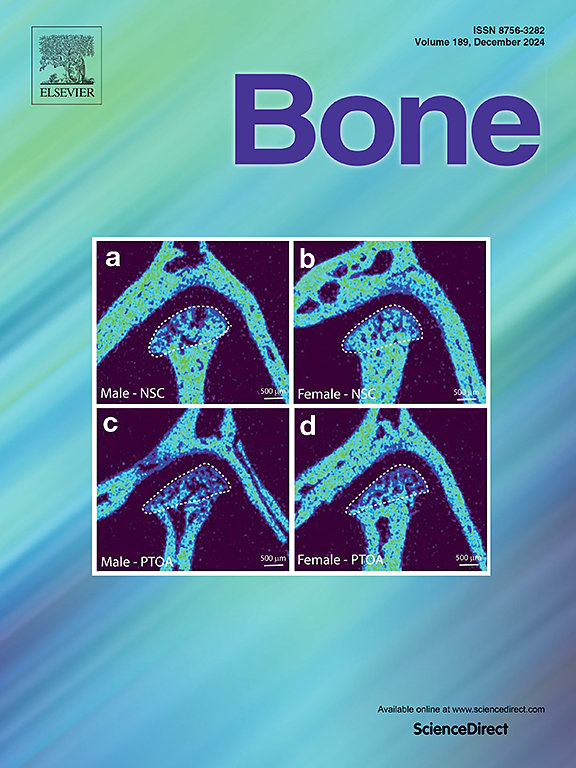休息-活动昼夜节律与骨质疏松症:一项前瞻性队列和孟德尔随机研究
IF 3.6
2区 医学
Q2 ENDOCRINOLOGY & METABOLISM
引用次数: 0
摘要
研究背景:休息-活动昼夜节律(RAR)紊乱与骨质疏松症风险增加有关。然而,仍然缺乏前瞻性研究来检验这种关联。方法:本纵向队列研究利用英国生物银行的数据,包括90,029名参与者,他们最初没有OP,基线时具有可靠的加速度计数据,中位随访时间为8.1年。在最初两年内新近失去随访的参与者被排除在外。我们评估了11个RAR变量,包括非参数变量相对振幅(RA)、最活跃的10小时周期计数(M10)、最不活跃的5小时周期计数(L5)、日间稳定性(IS)和日内变异性(IV),以及参数变量振幅、中值、伪f统计量、顶相、α和β与OP风险的关系,使用Cox模型调整了多个混杂因素。进行中介分析以确定炎症标志物是否介导RAR变量与OP发生率之间的关联。此外,进行了双样本MR分析来推断因果关系。结果本研究共记录了1702例新发OP病例。较高的RA(校正危险比0.87 [95% CI 0.83-0.92])和M10(0.73[0.60-0.89])与较低的骨质疏松症风险相关,而较高的L5(1.09[1.04-1.15])与较高的骨质疏松症风险相关。这3个RAR变量与骨质疏松风险之间的关联可能是由白细胞计数和血小板/淋巴细胞比介导的,中介比例在6.06% ~ 13.84%之间。较高的参数变量alpha值(0.92[0.88-0.97])与较低的骨质疏松风险相关。两样本MR分析表明RA、L5、伪f和股骨颈骨密度之间存在潜在的显著关联,与观察结果一致。我们的研究结果表明,昼夜节律紊乱(如RAR变量受损所示)与较高的骨质疏松风险相关。昼夜节律紊乱可能是一种可改变的危险因素,可作为骨质疏松症预防的目标。本文章由计算机程序翻译,如有差异,请以英文原文为准。
Rest-activity circadian rhythms and osteoporosis: A prospective cohort and Mendelian randomization study
Background
Disruptions in rest-activity circadian rhythms (RAR) have been shown to be associated with an increased risk of osteoporosis. However, there remains a scarcity of prospective studies examining this association.
Methods
This longitudinal cohort study utilized data from the UK Biobank, including 90,029 participants who were initially free of OP and had reliable accelerometer data at baseline, with a median follow-up time of 8.1 years. Participants newly lost to follow-up within the first two years were excluded. We assessed the associations of eleven RAR variables including nonparametric variables relative amplitude (RA), most active 10-h period counts (M10), least active 5-h period counts (L5), interdaily stability (IS), and intradaily variability (IV), and parametric variables amplitude, mesor, pseudo-F statistic, acrophase, alpha, and beta with the risk of OP using Cox models adjusted for multiple confounders. Mediation analyses were conducted to determine whether inflammatory markers mediated the associations between RAR variables and OP incidence. Additionally, two-sample MR analyses were conducted to infer causality.
Results
In this study, 1702 new-onset OP cases were documented. Higher RA(adjusted hazard ratio 0.87 [95 % CI 0.83–0.92]) and M10 (0.73 [0.60–0.89]) were associated with a lower risk of osteoporosis, while higher L5 (1.09 [1.04–1.15]) was associated with an increased risk. The associations between these three RAR variables and osteoporosis risk were possibly mediated by leukocyte count and platelet-to-lymphocyte ratio, with mediation proportions ranging from 6.06 % to 13.84 %. Higher alpha of parametric variables (0.92 [0.88–0.97]) were associated with a lower risk of osteoporosis. Two-sample MR analyses suggested potential significant associations between RA, L5, pseudo-F and femoral neck bone mineral density, consistent with observational results.
Conclusions
Our findings suggest that circadian rhythm disruption, as indicated by impaired RAR variables, was associated with higher osteoporosis risk. Circadian rhythm disruption may be a modifiable risk factor that could be targeted for osteoporosis prevention.
求助全文
通过发布文献求助,成功后即可免费获取论文全文。
去求助
来源期刊

Bone
医学-内分泌学与代谢
CiteScore
8.90
自引率
4.90%
发文量
264
审稿时长
30 days
期刊介绍:
BONE is an interdisciplinary forum for the rapid publication of original articles and reviews on basic, translational, and clinical aspects of bone and mineral metabolism. The Journal also encourages submissions related to interactions of bone with other organ systems, including cartilage, endocrine, muscle, fat, neural, vascular, gastrointestinal, hematopoietic, and immune systems. Particular attention is placed on the application of experimental studies to clinical practice.
 求助内容:
求助内容: 应助结果提醒方式:
应助结果提醒方式:


